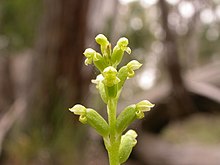| Revision as of 05:07, 27 March 2018 editGderrin (talk | contribs)Autopatrolled, Extended confirmed users, Page movers, New page reviewers58,561 editsm Distribution WA?← Previous edit | Revision as of 08:43, 12 July 2019 edit undoWimpus (talk | contribs)Extended confirmed users2,917 edits →Taxonomy and naming: Brown p. 45: -florus, flowered (as in multiflorus) , < flos, floris, flower; -us, -a, -um -> misinterpretation of the source.Next edit → | ||
| Line 14: | Line 14: | ||
| ==Taxonomy and naming== | ==Taxonomy and naming== | ||
| ''Microtis parviflora'' was first formally described by ] in 1810 and the description was published in '']''.<ref name=APNI>{{cite web|title=''Microtis parviflora''|url=https://id.biodiversity.org.au/instance/apni/486461|publisher=APNI|accessdate=10 October 2017}}</ref><ref name="R.Br.">{{cite book|last1=Brown|first1=Robert|title=Prodromus florae Novae Hollandiae|date=1810|location=London|page =321|url=https://www.biodiversitylibrary.org/item/21771#page/191/mode/1up|accessdate=10 October 2017}}</ref> The ] (''parviflora'') is derived from the ] words ''parvus'' meaning "small"<ref name="RWB">{{cite book|last1=Brown|first1=Roland Wilbur|title=The Composition of Scientific Words|date=1956|publisher=Smithsonian Institution Press|location=Washington, D.C.}}</ref>{{rp|590}} and '' |
''Microtis parviflora'' was first formally described by ] in 1810 and the description was published in '']''.<ref name=APNI>{{cite web|title=''Microtis parviflora''|url=https://id.biodiversity.org.au/instance/apni/486461|publisher=APNI|accessdate=10 October 2017}}</ref><ref name="R.Br.">{{cite book|last1=Brown|first1=Robert|title=Prodromus florae Novae Hollandiae|date=1810|location=London|page =321|url=https://www.biodiversitylibrary.org/item/21771#page/191/mode/1up|accessdate=10 October 2017}}</ref> The ] (''parviflora'') is derived from the ] words ''parvus'' meaning "small"<ref name="RWB">{{cite book|last1=Brown|first1=Roland Wilbur|title=The Composition of Scientific Words|date=1956|publisher=Smithsonian Institution Press|location=Washington, D.C.}}</ref>{{rp|590}} and ''flos'' meaning "flower".<ref name="RWB" />{{rp|45}}<ref name="RWB" />{{rp|466}} | ||
| ==Distribution and habitat== | ==Distribution and habitat== | ||
Revision as of 08:43, 12 July 2019
| Slender onion-orchid | |
|---|---|

| |
| Microtis parviflora growing on Black Mountain in the A.C.T. | |
| Scientific classification | |
| Kingdom: | Plantae |
| Clade: | Tracheophytes |
| Clade: | Angiosperms |
| Clade: | Monocots |
| Order: | Asparagales |
| Family: | Orchidaceae |
| Subfamily: | Orchidoideae |
| Tribe: | Diurideae |
| Genus: | Microtis |
| Species: | M. parviflora |
| Binomial name | |
| Microtis parviflora R.Br. | |
Microtis parviflora, commonly known as the slender onion-orchid, is a species of orchid which is native to Australia and New Zealand. It occurs in all states of Australia but is not known from the Northern Territory and may not occur in Western Australia. As with others in the genus, it has a single erect, smooth, tubular leaf and up to eighty flowers on an erect flower spike.

Description
Microtis parviflora is a terrestrial, perennial, deciduous, herb with an underground tuber and a single erect, smooth, tubular leaf 20–50 cm (8–20 in) long. The leaf is pointed at the end and usually longer than the flower spike. Between ten and eighty small green flowers are crowded on an erect, fleshy raceme 20–50 cm (8–20 in) tall. Each flower has a pedicel about 1 mm (0.04 in) long allowing the flower to stand out from the spike. The ovary is more or less oval in shape, 3–5 mm (0.1–0.2 in) long. The dorsal sepal is egg-shaped to round, about 2 mm (0.08 in) long and with the petals forms a hood over the column. The lateral sepals are linear in shape, slightly shorter than the dorsal sepal, and roll back as they age. The labellum is 1 or 2 mm (0.04 or 0.08 in) long, more or less heart-shaped and turns downwards in a semi-circle. There are two relatively large, egg-shaped calli at the base of the labellum. Flowering occurs from October to February, or to March in New Zealand.
Taxonomy and naming
Microtis parviflora was first formally described by Robert Brown in 1810 and the description was published in Prodromus Florae Novae Hollandiae et Insulae Van Diemen. The specific epithet (parviflora) is derived from the Latin words parvus meaning "small" and flos meaning "flower".
Distribution and habitat
The slender onion-orchid occurs in all the states of Australia but not the Northern Territory. There is some doubt about its presence in Western Australia, although several authors have noted its presence in semi-arid areas of that state.
In Australia, this species is common and widespread in many habitats, more usually in moist soils. It is found on the North and South Islands of New Zealand where it usually grows in places with little overhead vegetation.
References
- Bates, Robert (1984). "The genus Microtis R.Br. (Orchidaceae): A taxonomic revision with notes on biology" (PDF). Journal of the Adelaide Botanic Garden. 7 (1): 66–68. Retrieved 10 October 2017.
- ^ Jeanes, Jeff. "Microtis parviflora". Royal Botanic Gardens, Melbourne - vicflora. Retrieved 10 October 2017.
- ^ Rowe, Ross R. "Microtis parviflora". Royal Botanic Garden Sydney - plantnet. Retrieved 10 October 2017.
- ^ de Lange, Peter J. "Microtis parviflora". New Zealand Plant Conservation Network. Retrieved 10 October 2017.
- "Microtis parviflora". APNI. Retrieved 10 October 2017.
- Brown, Robert (1810). Prodromus florae Novae Hollandiae. London. p. 321. Retrieved 10 October 2017.
- ^ Brown, Roland Wilbur (1956). The Composition of Scientific Words. Washington, D.C.: Smithsonian Institution Press.
- Bates, Robert (1990). "Notes of the genus Microtis (Orchidaceae) in Western Australia with the description of two new taxa" (PDF). Journal of the Adelaide Botanic Garden. 13: 57–58. Retrieved 10 October 2017.
- "Microtis parviflora". New Zealand Native Orchid Group. Retrieved 10 October 2017.
External links
- [REDACTED] Media related to Microtis media at Wikimedia Commons
- [REDACTED] Data related to Microtis media at Wikispecies